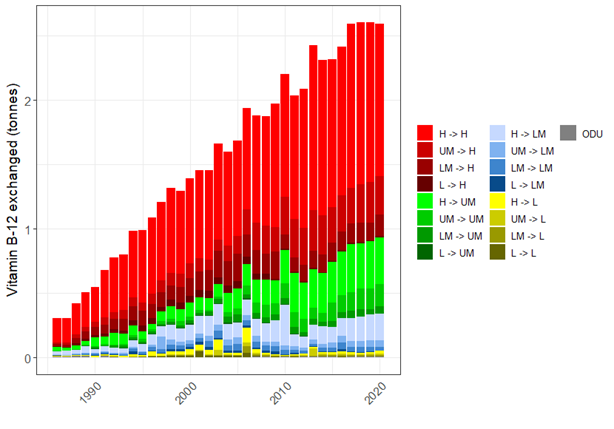
23 Jan New tool for examining global nutrient trade available
This Thought for Food details a recent publication on global nutrient trade and an accompanying app now available on the SNi website.
Have you ever looked down at your breakfast, lunch, or dinner, and considered where the various ingredients had travelled from to reach your plate? A basic sandwich in New Zealand can easily represent five countries: an Australian wheat and Indian sesame seeds roll, Danish salami, local lettuce and cheese, seasoned with Vietnamese pepper. And because your food travels a long way to reach you, so does your nutrition.
In a previous Thought for Food and video , we reported some results of our modelling work focused on nutrient flows in the Pacific and their role in food security. Now, a broader analysis of global nutrient trade over time and its impact on health has been published in Global Food Security by the SNi team and collaborators from Brazil. It shows the variation in nutrient trade between countries with differing wealth, and some positive links between nutrient trade and health.
The team built a large dataset of all flows of food for human consumption between 254 countries from 1986-2020 and used this to work out the flows of 48 essential nutrients over the same period. As this is too much information for a scientific paper, the team built an interactive app to explore the data (which you can access here) and focused the paper on a few key nutrients: protein, calcium, iron, and vitamins A and B12. These are often used in analyses of food security and some are undersupplied in many parts of the world.
Nutrient trade over the 35 years analysed has grown rapidly, as shown in the figure below for vitamin B12. Particularly for vitamin B12, but also for the other nutrients analysed, high-income countries were the biggest importers, largely trading with other high-income countries. This is despite representing only ~15% of the global population. In contrast, low-income countries have little involvement in global trade of any nutrients.

Diving into the detail of individual countries or nutrients can be done through the interactive app. Below is an example for New Zealand protein exports, which are dominated by milk and meat , with China the major partner . The quantity exported would be sufficient to feed nearly 7 times New Zealand’s own population, although in a country like China this is only a small fraction of the population. In contrast, nearly 60% of New Zealand’s protein imports come from Australia, largely in wheat and wheat products, and the country imports enough protein to meet around half its population’s need.

Separately to the nutrient trade quantification, the paper also analysed the socioeconomic, demographic, and health outcome data potentially associated with food consumption patterns and nutrient trade. The findings were that higher involvement in nutrient trade networks was significantly associated with improvements in infant mortality rates, prevalence of anaemia in women of reproductive age, and life expectancy.
It is concerning to see the low involvement of low-income countries in nutrient trade, particularly with the positive benefits this can bring for population health. The nutrient trade app, coupled with DELTA Model® data, gives the context for how important traded nutrients are in meeting national population requirements. This knowledge can be used to identify weaknesses in the global food system, and which shocks (climatic, political, or biological) might have the greatest consequences for nutrition.
Since food trade plays a key role in fostering food security and good nutrition and has grown rapidly in both mass and economic value over the last 35 years, understanding its importance for nutrition is essential. This can then be coupled with other knowledge and modelling around food production, within-country distribution, and consumption for a more complete view of food systems.
This Thought for Food was written by Dr Nick Smith, Research Officer, with the support of the SNi® team.
Title photo by Tom Fisk on Pexels.com





